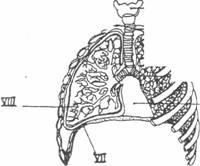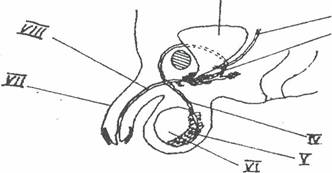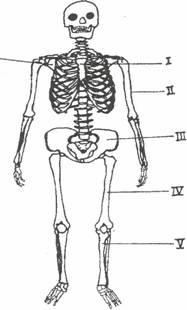WAEC 2018 Health Science Past Questions and Answers
Below Are WAEC Past Questions and Answers For Health ScienceQuestion 1
Study the diagram below and use it to answer questions
I(a) to I(d).

(a) (i) What does the diagram above represent? [ 1 mark]
(ii) Name the parts labelled I to VIII [ 4 marks]
(iii) State one function each of the parts Labelled II, III, V and VII [ 4 marks]
(b) State the importance of the part labelled IV to human life [2 marks]
(c) Outline five human practices which are dangerous to the part labelled IV [5 marks]
(d) State four diseases associated with the part labelled IV [ 4 marks]
Observation: This question was attempted by many candidates and candidates performed fairly well. In part (a)(i) candidates identified the diagram as respiratory system correctly, while some were not able to identify the diagram. In a)(ii) candidates named the parts labelled correctly while some candidates named the parts labelled with wrong spellings, in (a)(iii) candidates could not state one function of the parts labelled II,III, V and VII correctly. In part (c) candidates outlined human practices which are dangerous to the lung however, few candidates wrongly
mentioned prostitution as practice dangerous to the lung. In part (d) candidates stated diseases associated with the lung.
The expected answers were as follows:
(a) (i) Representation of the diagram
Respiratory system.
(ii) Naming the parts labelled
- Larynx/voice box
- Trachea/wind pipe
- Rib
- Lung
- Bronchus
- Space for the heart/space
- Diaphragm
- Bronchiole
> Trachea/wind pipe for passage of air into the lungs/traps air impurities
> Rib - protects lungs/involved in mechanism of inspiration and
expiration breathing
> Bronchus - passage of air into and out of the lungs/traps impurities
> Diaphragm - Regulates/increases/decreases volume of thoracic
cavity/assist in breathing
(b) Importance of IV(Lungs)
- site of gaseous exchange
- breathing helps excretes carbon dioxide and water vapour.
(c)Dangerous Practices
- Inadequate exercise
- Bad posture/named
- Breathing through the mouth
- Smoking of cigarettes
- Failure to open windows for ventilation
- Sniffing of drugs and hard substances
- Exposure to air pollutants/polluting the air/named.
- Cancer
- Pneumonia
- Tuberculosis
- Bronchitis
- Influenza
- SARS
- Emphysema
- Whooping cough
The diagram below is an illustration of the male urine-genitial system study it carefullyu and use it to answer question 2(a) to 2(c)

(a) Name the parts labelled I to VIII [ 4 marks]
(b) State one function each of the parts labelled V,VI, and VIII [3 marks]
(c) Name three diseases associated with the system. [3 marks]
Observation: This question was attempted by many candidates and candidates performed fairly well. In part (a) candidates named the part labeled correctly but made mistakes in spellings. In part (b) candidates mixed up function of the part labelled V (epididymis) as production of sperm with function of the part labelled VI (Testis) as stores sperm while some candidates could not state function of the part labelled VIII (urethra) In part (c) candidates named diseases associated with the urino-genital system with wrong spellings.
The expected answers were as follows:
(a) Naming the parts labelled
- Urinary bladder
- Ureter
- Prostate gland
- Sperm duct/vas deferens
- Epididymis
- Testis
- Penis
- Urethra.
Function of 5
Stores sperm
Produces secretion that makes sperm active
Function of 6
For sperm production
Production of male sex hormone/named sex hormone
Function of 7
Passage of urine
Conveying spennlsemen during sex.
( c) Diseases associated with the system
- Syphilis
- Gonorrhoaa
- Urethritis
- Kidney stone
- Urine retention/enlarged prostate gland
- Genital herpes
The diagram below illustration the skeleton system of humans
Study it carefully and use it to answer questions 3(a) to 3(d).

(a) Name the parts labelled I to VI [3 marks]
(b) Mention one labelled part which represents a bone in the
(i)axial skeleton;
(ii)appendicular skeleton. [ 2 marks]
(c)Name the joint between
(i)II and VI
(ii)IV and V. [2 marks]
(dState three ways in which the skeletal system is important to the human body. [3 marks]
Observation: This question was attempted by many candidates and candidates did well in it. In part (a) candidates named the part labelled I to VII correctly however, few candidates lost marks because of wrong spellings. In part (b) some candidates took sternum as appendicular skeleton while humerus as axial skeleton. In part (c) candidates named the joint between (i) II and VI (II) IV and V correctly. In part (d) candidates stated ways in which the skeleton system is important to the human body.
The expected answers were as follows:
(a) Naming the parts labelled
- Sternum
- Humerus
- Pelvis/pelvic bone
- Femur
- Tibia
- Scapula
I1Sternum
(ii) Appendicular Skeleton
IIIIll/IV /V NIl named bone/humerus/pelvis/femur/tibia/scapula
(c) Naming the joint between
(i) II and VI - ball and socket joint
(ii) IV and V - hinge joint.
(d) Importance of the Skeleton
- Protects internal organs/soft delicate organ/named
- Gives shape to the body/forms the framework of the body
- Provides surface for attachment of muscles
- Provides lever for movement
- It aids breathing
- Aids production of red blood cells
- Gives support.
(a) (i) What is posture? [2 marks]
(ii) State three causes of postural defects [3 marks]
(b) List three defects of the foot [ 3 marks]
(c) State two corrective measures for postural defects [2 marks]
Observation: This question was attempted by many candidates and candidates performed poorly. In part (a)(i) candidates could not give definition of posture, in (a) (ii) candidates stated causes of postural defects. In part (b) candidates could not list defects of the foot. In part (c) candidates took taking drug as corrective measure for postural defect instead of rehabilitation and regular exercise.
The expected answers were as follows:
(a) (i) Posture
> Posture is the alignment of the body
> It is the way the body is held while standing/sitting and walking.
(ii) Causes of Postural defects
- Accident
- Congenital problem
- Imitation/peer influence/named
- Malnutrition
- Diseases/named
- Types of occupation
- Walking too early before normal age
- Unsuitable wears (clothes and shoes)/high heel shoes
- Carrying of heavy objects
- Poor postural habits/explained
- Flat foot
- High foot arch
- Club foot
- Everted foot/inverted foot.
- Good nutrition/eating balanced diet
- Physical exercise/recreation
- Medical rehabilitation/named
(a) List two natural sources of water [2 marks]
(b) State three general uses of water by humans [ 3 marks]
(c)Name the international health agencies/organizations associated with the following functions:
(i)standardization of drugs for international use;
(ii)performing first aid activities and training personnel in first aid;
(iii)provision of recreational facilities and equipment for school children;
(ivproviding information on outbreak of epidemics;
(v)rehabilitation of victims of wars, floods or drought.[ 5 marks]
Observation: This question was attempted by many candidates and candidates performance was very good. In part (a) candidates listed natural sources of water correctly. In part (b) candidates stated uses of water by humans. In part (c) candidates named the international health agencies/organizations associated with their functions however, some candidates lost mark because they interchange their function for one another.
The expected answers were as follows:
(a) Natural Sources of Water
- Rain water
- Spring water
- Well water/borehole/underground water
- River water
- Lake/lagoon
- Stream seal ocean/pond.
- For drinking
- For domestic use/washing/bathing/cooking
- For irrigation/agriculture
- Used in industry/power generation
- For fire fighting
- Transportation.
(i) WHO
(ii) Rea Cross
(iii) UNICEF
(iv) WHO
(v) Red Cross/Vv'HO/UNICEF
Question 6
(a) Mention the three body forms in humans [3 marks]
(b) State two features of each body form mentioned in (a) above [6 marks]
(c) State one factor necessary for the maintenance of health [ 1 mark]
Observation: This question was attempted by many candidates and candidates performance was poor. In part (a) some candidates mentioned body forms in humans however, few candidate lost mark due to their inability to mention body forms in humans. In part (b) candidates could not state features of body forms, few that mentioned features of body form took social emotional characteristics and activities of the body forms or types as the features. In part (c) some candidates stated factor necessary for the maintenance of health however, few lost mark due to their inability to state factor necessary for the maintenance of health.
The expected answers were as follows:
(a) Body forms in humans
- Endomorphs
- Mesomorphs
- Ectomorphs
- Endomorphs
- roundness and softness of the body
- possession of small bones
- large head and small neck
- possession of smooth body contours
- short and tapering limbs
- fatty breasts
- possession of wide buttocks
- large body frame.
- Ectopmorphs
- possession of fragile and delicate body structure
- Possession of thin bones and small muscles
- Small head with slender neck and waist
- Skin sometimes appears dry
- Flat abdomen with small buttocks, long thin legs
- Possession of protruded ribs, usually lack upper body strength and power.
- Balanced diet
- Physical exercise
- Personal hygiene
- Adequate rest
- Good/healthy environment
(a) State six factors that could contribute to juvenile delinquency. [ 6 marks]
(b) Mention four habits that are injurious to human health [ 4 marks]
Observation: This question was attempted by many candidates, the performance was fair. In part (a) few candidates stated factors that could contribute to juvenile delinquency however, some candidates lost mark due to their inability to state factors contributing to juvenile delinquency. In part (b) candidates mentioned habits that are injurious to human health correctly.
The expected answers were as follows:(a) Factors that could contribute to Juvenile delinquency
- Peer group/adult influence
- Broken home/ divorced/ separated homes
- Lack of parental care
- Unemployment/poverty
- High crime rates in the society/community
- Inadequate recreational facilities
- Uncensored media presentation/named
- smoking
- drug abuse
- drug addiction
- excessive drinking of alcohol
- prostitution
- over-eating/malnutrition
- lack of exercise
- poor personal hygiene/named.
